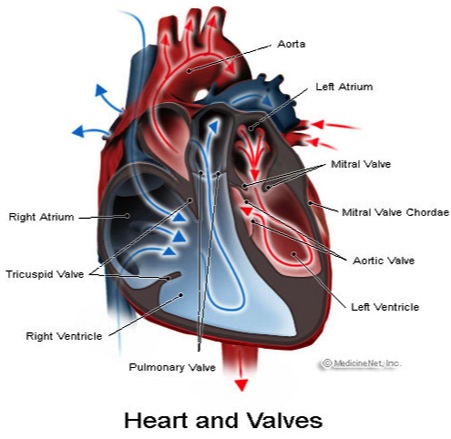[vc_row inner_container="true" no_margin="true" padding_top="0px" padding_bottom="0px" border="none"][vc_column width="1/1"][custom_headline type="center" level="h1" looks_like="h3" accent="true" style="margin-bottom:0;"]Valvular Heart Disease[/custom_headline][gap size="1.5em"][vc_row_inner no_margin="true" padding_top="0px" padding_bottom="0px" border="none"][vc_column_inner width="1/1"][text_output]According to the American Heart Association, about 5 million Americans are diagnosed with valvular heart disease each year. Valvular heart disease is caused by stenosis, or abnormal narrowing of the cardiac valves, causing obstructed blood flow and blood regurgitation. In essence, the valves just don't work as they are intended.
What Are the Types of Valve Disease?
There are several types of valvular heart disease, to include:
Valvular stenosis: When a valve opening is smaller than normal leading to heart failure.
Valvular Insufficiency: occurs when a valve does not close tightly, thus allowing blood to leak backwards.
What Causes Valvular Disease?
Valvular disease can be congenital or acquired sometime during life. Leaflets can be the wrong size, malformed, or are not connected to the annulus properly.
Bicuspid aortic valve disease is a congenital valve disease of the aortic valve. Instead of the normal three leaflets the bicuspid aortic valve has only two. The valve may be unable to open or close properly, or not able close tightly.
Acquired valve disease is when valves that were once normal, are now abnormal. These may due to a variety of diseases or infections, including rheumatic fever or endocarditis.
Mitral valve prolapse (MVP) is a very common, rarely causes symptoms, and usually doesn't require treatment.[/text_output][/vc_column_inner][/vc_row_inner][vc_row_inner][vc_column_inner width="1/3"][text_output]
Other Causes:[/text_output][icon_list style="margin: 0 0 20px 20px; padding:0;"][icon_list_item type="check"]heart attack[/icon_list_item][icon_list_item type="check"]cardiomyopathy[/icon_list_item][icon_list_item type="check"]syphilis[/icon_list_item][icon_list_item type="check"]high blood pressure[/icon_list_item][icon_list_item type="check"]aortic aneurysms[/icon_list_item][icon_list_item type="check"]connective tissue diseases[/icon_list_item][/icon_list][text_output]
Symptoms:[/text_output][icon_list style="margin: 0 0 20px 20px; padding:0;"][icon_list_item type="check"]Shortness of breath[/icon_list_item][icon_list_item type="check"]Weakness or dizziness[/icon_list_item][icon_list_item type="check"]chest discomfort[/icon_list_item][icon_list_item type="check"]heart palpations[/icon_list_item][icon_list_item type="check"]edema[/icon_list_item][icon_list_item type="check"]rapid weight gain[/icon_list_item][/icon_list][/vc_column_inner][vc_column_inner width="1/3"][text_output]
Diagnosis:[/text_output][icon_list style="margin: 0 0 20px 20px; padding:0;"][icon_list_item type="check"]Echocardiography[/icon_list_item][icon_list_item type="check"]Transesophageal echocardiography[/icon_list_item][icon_list_item type="check"]Cardiac catheterization (also called an angiogram)[/icon_list_item][icon_list_item type="check"]Radionuclide scans[/icon_list_item][icon_list_item type="check"]Magnetic resonance imaging (MRI)[/icon_list_item][/icon_list][text_output]Treatment involves protecting your valve from further damage, lessening symptoms, and repairing or replacing valves.[/text_output][text_output]
Medications:[/text_output][icon_list style="margin: 0 0 20px 20px; padding:0;"][icon_list_item type="check"]Diuretics[/icon_list_item][icon_list_item type="check"]Anti-arrhythmics[/icon_list_item][icon_list_item type="check"]Vasodilators[/icon_list_item][icon_list_item type="check"]Beta Blockers[/icon_list_item][icon_list_item type="check"]Blood thinners[/icon_list_item][/icon_list][/vc_column_inner][vc_column_inner width="1/3"][image type="none" float="none" info="none" info_place="top" info_trigger="hover" src="1747"][/vc_column_inner][/vc_row_inner][vc_row_inner no_margin="true" padding_top="0px" padding_bottom="0px" border="none"][vc_column_inner width="1/1"][text_output]
Protecting Yourself:
If you have valvular disease it is important to protect yourself against infection by taking care of your teeth and gums and taking antibiotics before undergoing any type of procedure that may cause bleeding. Make sure that all your doctors know you have valvular disease, and take all your medications to control any symptoms.
Content Resource: http://www.clivir.com/lessons/show/valvular-heart-disease.html[/text_output][/vc_column_inner][/vc_row_inner][gap size="5em"][/vc_column][/vc_row]


